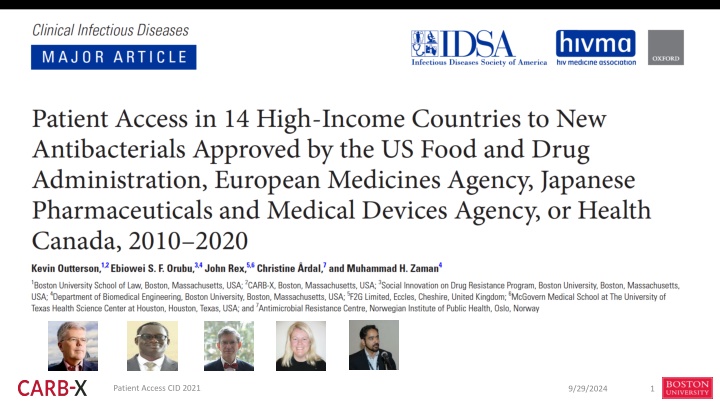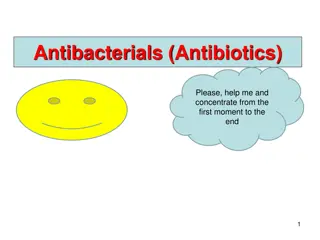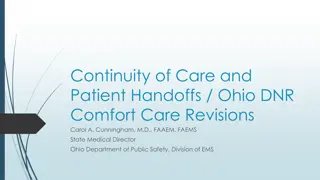Analysis of Antibacterials Commercial Launches and Patient Access Trends
The study examines the commercial launch and patient access of new antibacterials approved in the last decade. Results show challenges in timely launches across countries, with limited commercial success despite regulatory approvals. The impact of sponsor characteristics, drug resistance, and WHO list placement on market access is explored.
Download Presentation

Please find below an Image/Link to download the presentation.
The content on the website is provided AS IS for your information and personal use only. It may not be sold, licensed, or shared on other websites without obtaining consent from the author.If you encounter any issues during the download, it is possible that the publisher has removed the file from their server.
You are allowed to download the files provided on this website for personal or commercial use, subject to the condition that they are used lawfully. All files are the property of their respective owners.
The content on the website is provided AS IS for your information and personal use only. It may not be sold, licensed, or shared on other websites without obtaining consent from the author.
E N D
Presentation Transcript
Patient Access CID 2021 9/29/2024 1
Background Questions: Were the IDSA goals achieved? Are these drugs getting to patients and therefore improving clinical practice? Is the R&D ecosystem healthier now? IDSA. CID 2010:50;1081-1083. Patient Access CID 2021 9/29/2024 2
Data All new molecular entity systemic antibacterials first approved for human use by FDA, EMA, JPMD, or Health Canada from 1.1.2010 to 12.31.2019 Regulatory approval and commercial launch (first commercial sale) dates collected in the G7 and a convenience sample of 7 other high- income European countries Other drug data collected included sales in largest market for last 12 months; whether the drug was on various lists indicative of innovation or clinical need; and sponsor characteristics Complete Excel database available in the Boston University Institutional Data Repository: https://hdl.handle.net/2144/42657. Patient Access CID 2021 9/29/2024 3
Methods Descriptive statistics Calculate median launch lags (MLLs) for drugs with >1 launches Test correlations of MLLs with: Proxies for possible clinical importance from WHO & Pew Placement on the WHO Essential Medicines List & AWaRe List Drug Resistance Index Sponsor characteristics (large company v. SME) National total health expenditures (supplement) (World Bank) Patient Access CID 2021 9/29/2024 4
Results Top line results 18 NME antibacterials approved and launched In only 3 countries (US, UK, Sweden) were a majority of these 18 launched Regulatory approval by EMA did not lead to timely launch in many EMA countries MLLs were unrelated to proxies for innovation, drug resistance, or national health expenditures Placement on WHO Essential Medicines List predicted significantly longer MLLs Commercial prospects of the sponsors are very poor Patient Access CID 2021 9/29/2024 5
Results Number of commercial launches Number of commercial launches United States - 17 EMA* - 14 UK 11 Sweden 10 France 8 Germany 7 Italy 7 Norway 7 Spain 7 Greece 6 Romania 6 Croatia 5 Denmark 5 Japan 5 Canada - 2 *For EMA, approvals only Patient Access CID 2021 9/29/2024 6
Results Limited availability in high-income countries, outside US Approval and commercial launch in fourteen high-income countries of NME antibacterials first approved by FDA, EMA, PMDA, or Health Canada, 2010-2019 All data as of 12/31/20 Notes: INN = international nonproprietary name; Empty cell = not commercially launched, except in the EMA column where empty cell = not approved by EMA; Number = lag from first approval to commercial launch, in days, except in the EMA column where number = lag from first approval to EMA approval, in days. The US was the country for all first approvals and first commercial launches, with the exception of lascufloxacin, approved and launched only in Japan. Color key: green = lowest lag in days; red = highest lag in days; yellow = 50th percentile lag in days. Source: Outterson K, Orubu ESF, Rex J, rdal C, Zaman MH. Clin Infect Dis 2021. Patient Access CID 2021 9/29/2024 7
Figure 1. Median launch lag, in days (right axis) and number of launches (left axis) in 14 high-income countries for new molecular entity antibacterials first approved by the FDA, EMA, JPMDA, or Health Canada, 2010 2019. Results Abbreviations: EMA, European Medicines Agency; FDA, United States Food and Drug Administration; UK, United Kingdom; JPMDA, Japanese Pharmaceuticals and Medical Devices Agency. Patient Access CID 2021 9/29/2024 8
Results Figure 2. Delay in days before and after EMA approval for 13 recently approved antibacterials with approvals by both the FDA and EMA, in 5 high-income European countries. Abbreviations: EMA, European Medicines Agency; FDA, United States Food and Drug Administration; UK, United Kingdom. Patient Access CID 2021 9/29/2024 9
Scatter plot of DRI and MLLs for new molecular entity antibacterials first approved by the FDA, EMA, JPMDA, or Health Canada, 2010 2019, in 14 high-income countries Results 60 Romania 50 Median launch lag was not correlated to drug resistance in the country, as proxied by the Drug Resistance Index Spain Italy UK DRUG RESISTANCE INDEX (DRI) Greece France Croatia 40 30 Germany 20 Denmark USA Canada 10 Norway Sweden Japan 0 0 200 400 600 800 1000 1200 1400 1600 1800 MLL (IN DAYS) From the Supplement. Abbreviations: DRI, Drug Resistance Index; MLL, median launch lag Patient Access CID 2021 9/29/2024 10
Results Figure 3. United States trailing 12-month sales for antibacterials approved 2010 2019, by launch date, sponsor size, and number of high-income country commercial launches, with linear trend. Abbreviation: SME, small or medium enterprise. Patient Access CID 2021 9/29/2024 11
Conclusion Were the IDSA goals achieved? Numerically, yes Are these drugs getting to patients and therefore improving clinical practice? No, not in many high-income countries and therefor probably not in poorer settings as well Is the R&D ecosystem healthier now? No, the commercial prospects are very poor IDSA. CID 2010:50;1081-1083. Patient Access CID 2021 9/29/2024 12























